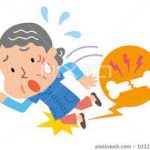
Falls in older persons occur commonly and usually result in injury. Fracture is a finding of traumatic injury to the bone. It damages the continuity of the bone.
People fall at every age, especially babies and older people( 65 and older). However, a fall at an older age can have serious consequences on your health and independence. It may cause a serious injury such as broken bones, a head injury, or a hip fracture.
How bad is my fall & fracture?
Mild: Minor or superficial injuries (mild swelling, bruising or skin discoloration) that can be treated at home (see the section below).
Moderate: You may experience pain, loss of limb strength, and difficulty in moving the limb. It requires medical treatment under your doctor’s supervision.
Severe: It involves displaced bone or open wound, loss of consciousness, heavy bleeding, and shortness of breath (dyspnea). Sometimes the bones are visible through the skin. It may limit self-care activities of daily life (eating, dressing, getting into or out of a bed or chair, taking a bath or shower, and using the toilet). It is an emergency that requires immediate treatment under your doctor’s supervision.
How to prevent fall?
- Get rid of things you could trip over.
- Add handrails inside and outside your bathroom and next to the toilet.
- Put railings on both sides of stairs.
- Install good lighting in your home. A well-lit home will help you avoid tripping over objects.
- Have your eyes checked by an eye doctor at least once a year, and be sure to update your eyeglasses if needed.
- Exercises to make your legs stronger and improve your balance.
- Use a walker if your doctor recommends it.
Managing mild fractures
- Try to stop bleeding as soon as possible. Apply pressure to the wound with a sterile bandage or a clean cloth.
- Stabilize the injured area. Don’t try to move or realign the bone or push a bone that’s sticking out back in.
- If professional help isn’t readily available, apply a splint to the area above and below the fracture sites. Padding the splints can help reduce discomfort.
- Apply ice packs to reduce swelling and relieve pain. Don’t apply ice directly to the skin. Wrap the ice in a towel or piece of clean cloth.
What are the causes?
- Balance problem(giddiness)
- Fatigue (Tiredness) due to chemotherapy and radiation therapy
- Muscle weakness(fatigue)
- Long term health condition
- Vision loss
- Old age
- Wet floors
- Slippery rugs